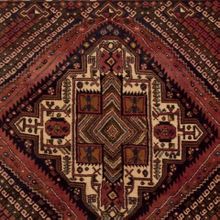Shahr-e-babak Rug
From the city of that name in southern Persia, the incredible Kerman carpet is a soft treasure, and among the most beautiful designs woven. The traditional motif has the main border and central medallion in an intricately-detailed, ornate architectural or floral theme in the palest pastels with white-and-gold trim. This typically contrasts with an open field of a rich solid cranberry red, navy blue or other strong colors. Others patterns include the finer Lavar style with garden, tree-of-life, vase and all-over mille fleur designs, or the many pictorials which tell the story of a significant figure or event in history. Silk is almost never used.
| Shahr-e-babak Rug | |
|---|---|
 Design of Shahr-e-babak Rug (Rugman) | |
| General information | |
| Name | Shahr-e-babak Rug |
| Original name | قالی شهربابک |
| Alternative name(s) | Shahr-e-babak Carpet |
| Origin | |
| Category | Village |
| Technical information | |
| Common designs | Medallion, Geometric, Vase |
| Common colors | Red, Brown, White, Golden, Blue |
| Dyeing method | Natural, Synthetic |
| Pile material | Wool |
| Foundation material | Cotton |
| Knot type | Asymmetrical (Persian) |
History
Shahrbabak, also spelled Shahr-e Babak, is an ancient town located in the KERMAN Province of south central Iran. It was founded during the Sasanian Dynasty eighteen hundred years ago. The majority of the population here and in the surrounding area belongs to the Afshar tribe.
Shahrbabak rugs are known in the market from the late nineteenth century.[1]
Materials
Foundation and Pile
Recent weavings have a cotton foundation and a wool pile, but older Shahrbabak rugs were woven with a wool foundation and a wool pile.[2]
Techniques and structures
Color and dyeing
The colors used for the fields are ivory, dark blues, or reds. In addition, blues, browns, greens, yellows, and cinnamon are used in the borders, medallion, and design elements.[3]
Motifs and Designs
The rug designs are geometric, in allover or medallion styles. The rugs show influences from other Kerman Province nomadic carpets, as well as TURKMEN RUGS, Caucasian (CAUCASUS region) rugs, and the BALUCH, LORI, QASHQAI, and SHIRAZ tribes. In general, the medallion weavings have one, two, or three lozenge-shaped devices surrounded by motifs decorated in a parallel style.
The patterns in the field feature floral sprays, Boteh (paisley), Star, and other elements. Shahrbabak allover patterns employ Boteh, French Flower Bouquet, Lattice, Minakhani, Shrub, Star, and other designs. The main borders are narrow, like inany other tribal weavings, and have guard borders on each side. The borders are geometric: repeating flower heads, vines, and leaves, continuous star or tribal motifs are rendered. By the late twentieth century, some Shahrbabak weavers switched from using their traditional tribal designs to making rugs similar to those of other weaving regions in Iran in order to meet domestic and foreign export needs.[4]
Weaving techniques
The Persian (asymmetric) knot is universally used. Flatwoven KILIM rugs also were made for use as floor coverings, storage bags, and other tribal necessities. Shahrbabak pile and flatwoven rugs were considered inexpensive, and were suitable for the local market and foreign export. These rugs were made as floor coverings and as nomadic items woven for personal use. Shahrbabak formats range from small bags to rugs approximately eight feet by five feet. The grade quality ranges from medium to good.[5]
See also
Kerman Rug, Turkoman Rug, Baluch Rug, Lori Rug, Qashqai Rug, Shiraz Rug
References
Bibliography
- Abraham Levi Moheban, (2015), The Encyclopedia of Antique Carpets: Twenty-Five Centuries of Weaving, NewYork: Princeton Architectural Press.